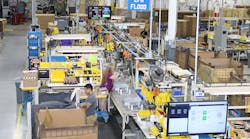The general-illumination market is the next big challenge and major market opportunity for LED manufacturers but poses a testing challenge as different applications and customers demand different capabilities in LED components. Iain Black, VP of worldwide manufacturing, engineering, and innovation at Philips Lumileds, is squarely focused on the challenge. In this article, he offers some insight into how manufacturers approach the component market with the overarching goal of assisting luminaire manufacturers and lighting designers in furthering the adoption of SSL.
LEDs Magazine spoke to Black as a preview to his Strategies in Light (SIL) keynote address entitled "LED manufacturing challenges – Dealing with complexity in an evolving market." The keynote address is part of the LED Manufacturing track at SIL, and Black will focus on the challenge relative to general illumination, and to meeting performance and cost goals that can enable broader SSL deployment.
Asked to summarize the challenge, Black said, "The illumination space is highly diverse in terms of types and sizes of customers, and also diverse in terms of the specifications that different customers care about."
As a simple example of diverse needs, Black noted the different requirements of the professional and consumer spaces. The former segment cares far more about performance and quality and the latter far more about price. Technical diversity starts with simple characteristics such as directional or non-directional sources and escalates in complexity. Black said that he hopes to provide context on the impact the diverse requirements place on an LED vendor trying to service the space.
Black's description of the market led to a question. Why don't you produce an LED for each application? He said of course, "That isn't a realistic approach." Such an approach would result in far too many products in the manufacturer's portfolio and run contrary to the high-volume, low-cost goal.
Strategies for component diversity
Regarding the problem of diverse requirements, Black said manufacturers have several strategic avenues to address the challenge. He said one option is a building-block type strategy. Essentially you can mix a finite set of die, package, phosphor, and other elements to create components for different applications.
"Another option is selecting at what level in the chain you address certain markets – whether you produce light engines or discrete LEDs," said Black. "Those kinds of solutions allow you to engineer results to address the market with a limited manufacturing set."
Indeed the market for LED modules and subassemblies such as LEDs mounted on chip-on-board (COB) products is growing and allows luminaire developers faster time to market. Moreover, a key goal for Philips Lumileds is making it simpler for luminaire makers to get products to market.
Presently, Philips Lumileds doesn't offer LED subassemblies for general-illumination applications. "Those are spaces that we've been looking at to address," said Black. "But we don't have products in that space presently." He pointed out, however, that Philips has deep experience in subassemblies in other application segments such as automotive.
Component die architecture
Getting back to the LED component itself, we asked Black about the breadth of die solutions needed to serve the broad application segment. "It’s always dependent on having the right performance, but a surface emitter is an effective solution," said Black. "It doesn't play itself out of any application."
Black said that side emitters and other LED structures lend themselves to different niches in the space, but that the application of each is limited. He said, "Currently we address all of the segments with fundamentally the same kind of die architecture. That's not possible, by the way, with some of the other architectures."
For example, Black discussed limitations for lateral die architectures. "If you are going to produce a side-emitting, die-in-a-cup solution with a dispensed phosphor, you're never going to use that LED in a directional applications such as a spot," said Black. He added that such a die might work fine in a light bulb.
Black said that Philips remains open to new structures yet is focused on the most efficient path to serving diverse applications. "Philosophically we don't want to make many architectures," said Black. "But we won’t tie ourselves saying that we will only ever make one."
The SSL cost challenge
The abstract for Black's keynote mentions low-cost as a challenge, but Black intends to focus more on cost as a gating factor on SSL adoption than purely on low-cost components. He said, "Everyone is aware that LED adoption is going to be accelerated by critical product cost targets being reached." But he also noted that questions remain as to whether superior system design, superior efficacy, or low-cost LED components will have the greatest impact on SSL uptake. On that topic, Black said, "I think the answer to that is all of the above."
Concluding, Black brought the conversation back around to strategies for mitigating the impact of different application requirements in LED manufacturing. He asked philosophically, "How to you meet the requirements without producing a supply chain in my manufacturing operations that's unsustainable by cost targets?"
The answer, according to Black, is a combination of strategies including packaging, die architecture and structure, and the aforementioned different entry points with approaches such as subassemblies. For the luminaire maker, the challenge will be how to work with a suppliers such as Philips and deliver the end products that lighting designers will specify, and that the diverse customer base will buy and install.
Iain Black's keynote address is scheduled for Wednesday, February 8 at 1:30 PM. SIL will run February 7-9, 2012 at the Santa Clara Convention Center in Santa Clara, California. The conference will feature parallel HB-LED, LEDs in Lighting, and LED Manufacturing Tracks. The 2012 conference theme is "Navigating the dynamic LED and lighting markets."




